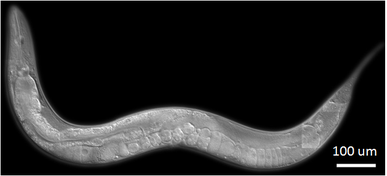Characterization of pathways required for starvation longevity in Caenorhabditis elegansGrowth and development is controlled by specific sets of gene products (proteins and RNAs), that interact to form metabolic and developmental pathways. Mutations in these genes can result in abnormal growth of cells, leading to diseases such as cancer. "Phosphatase and tensin homolog" (PTEN) is one of the main proteins that control developmental and growth processes in humans. In the nematode Caenorhabditis elegans, DAF-18 is the homolog of PTEN. At the L1 larval stage, worms use an insulin-like signalling pathway to detect the availability of nutrients. DAF-18 is an antagonist of the insulin signalling pathway and is essential in maintaining quiescence during L1 arrest. Insulin-like peptides bind to the insulin receptor triggering a signal transduction pathway, which inhibits a transcription factor (DAF-16/FOXO) from entering the nucleus and activating the transcription of stress resistant genes. DAF-16 is located downstream of DAF-18. In L1 arrest, wild-type worms can survive up to 22 days without food. We and others have shown that daf-16 mutants show a decreased survival of 13 days in L1 arrest while daf-18 mutants can only survive up to 3-4 days. This discrepancy in time suggests that although DAF-18 is upstream of DAF-16, DAF-18 has additional functions essential in maintaining L1 arrest and L1 is, in part, independent of DAF-16 signalling. The aim of this study is to identify a potential alternate DAF-18 pathway, which works independently of DAF-16 and plays a crucial role in L1 survival. I predict that over- or under-expressing genes downstream of daf-18 in the alternate pathway will allow the daf-18 mutant worms to live longer than 4 days. I was able to isolate two suppressors through EMS screening, that can enhance the survival up to almost wild type even when DAF-18 is mutated. These mutants can help us to identify the proposed alternate pathway. I also studied the effect of DAF-2 on L1 arrest with somatic daf-18 rescue. The discovery of a new pathway will provide a better understanding of larval growth and development in C. elegans. Moreover, these findings could identify other genes that play major roles in control of cellular growth and the development of cancer.
|
Archives
February 2021
|

